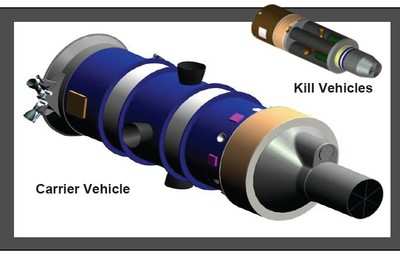Fri, May 08, 2009
$17 Billion Cut... But Trillions More Spent Elsewhere
The Obama Administration, in the process of spending trillions
of dollars for all manner of programs and projects, is trumpeted
the 17 Billion dollars it is trying to cut from the Federal Budget.
Rather than try to digest them all en masse, we'll look at each of
them one at a time and allow you to make up YOUR mind as to the
rationale and wisdom for the decisions included below. Herewith;
another of the programs on the chopping block that has an aviation
or aerospace connotation.

From the 'Terminations, Reductions, and Savings' document
published this week by the OMB, as part of the FY 2010 US
Budget:
Proposal: The Administration proposes to
terminate the Multiple Kill Vehicle (MKV), which is a long-term
research and development program designed to counter ballistic
missile threats by using several "kill" vehicles launched from a
single interceptor, or missile. The Administration will instead
focus on proven, near-term missile defense programs that can
provide more immediate defenses of the United States, its deployed
forces, and allies against ballistic missile attack.
Justification: The primary reason the
Administration proposes to terminate this long-term development
program is to focus, instead, on proven, near-term missile defense
programs, such as the Terminal High Altitude Area Defense (THAAD)
and the Aegis Ballistic Missile Defense programs. The capabilities
of the THAAD and Aegis Ballistic Missile Defense programs have been
demonstrated through numerous successful flight tests.

This termination of MKV will save over $4 billion from 2010
through 2015. In addition, program requirements are uncertain and
the program is already behind schedule and over budget because of
technological problems. In its 2009 Assessments of Selected Weapon
Programs, the Government Accountability Office (GAO) assessed 16 of
the program's critical technologies as immature and questioned
whether the program could achieve its goals because it has yet to
set top-level requirements. In addition, in a March 2009 report,
GAO pointed out that MKV experienced software development problems
that delayed its planned 2008 fall test by several months.2 In that
same report, GAO estimated that one of MKV's task orders would have
a cost overrun of between $1.6 million and $2.5 million, or between
8 to 13 percent, above the original budgeted amount.
More News
“These new aircraft strengthen our ability to respond quickly, train effectively and support communities nationwide. Textron Aviation has been a steadfast supporter in helpin>[...]
From 2011 (YouTube Edition): Rugged, Legendary, STOL Twin Makes A Comeback The de Havilland Twin Otter is an airplane with a long history, and it gained a reputation as a workhorse>[...]
A Wind Gust Lifted The Right Wing And The Airplane Turned To The Left Analysis: The pilot was departing from a 2,395-ft-long by 50-ft-wide turf runway. The pilot reported that afte>[...]
Have A Story That NEEDS To Be Featured On Aero-News? Here’s How To Submit A Story To Our Team Some of the greatest new stories ANN has ever covered have been submitted by our>[...]
Braking Action Advisories When tower controllers receive runway braking action reports which include the terms “medium," “poor," or “nil," or whenever weather con>[...]
 Aero-News: Quote of the Day (12.18.25)
Aero-News: Quote of the Day (12.18.25) Classic Aero-TV: Viking Twin Otter 400--Bringing the DHC-6 Back Into Production
Classic Aero-TV: Viking Twin Otter 400--Bringing the DHC-6 Back Into Production NTSB Final Report: Rans Employee Flying Club Rans S-6ES Coyote II
NTSB Final Report: Rans Employee Flying Club Rans S-6ES Coyote II ANN FAQ: Submit a News Story!
ANN FAQ: Submit a News Story! ANN's Daily Aero-Term (12.18.25): Braking Action Advisories
ANN's Daily Aero-Term (12.18.25): Braking Action Advisories




